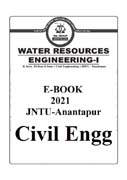

Note: Please check your Spam or Junk folder, in case you didn't receive the email with verification code.
SYLLABUS
UNIT-I
INTRODUCTION TO HYDROLOGY Engineering hydrology and its applications – Hydrologic cycle – Precipitation-types and forms – Rainfall measurement – Types of rain gauges – Computation of average rainfall over a basin – Presentation and interpretation of rainfall data. DESCRIPTIVE HYDROLOGY Evaporation- factors affecting evaporation – Measurement of evaporation – Infiltration- factors affecting infiltration, measurement of infiltration – Infiltration indices, Run off- factors affecting run-off, Computation of run-off – Design flood, Estimation of maximum rate of run-off, Separation of base flow.
UNIT-II
HYDROGRAPH ANALYSIS Hydrograph, Unit Hydrograph – Construction and limitations of unit hydrograph – Application of the unit hydrograph to the construction of a flood hydrograph resulting from rainfall of unit duration, S-hydrograph. GROUND WATER Introduction, Aquifer, Aquiclude, Aquifuge, Aquifer parameters-Porosity, Specific yield, Specific retention, Divisions of Sub – Surface water, Water table, Types of aquifers – Storage coefficient, coefficient of permeability and transmissibility, well hydraulics-Darcys law, Steady radial flow to a well – Dupuits theory for confined and unconfined aquifers, Tube well, Open well, Yield of an open well – Constant level pumping test, Recuperation test.
UNIT-III
IRRIGATION Introduction, Necessity and importance of irrigation, advantages and IlI effects of irrigation, types of irrigation, methods of application of irrigation water – Quality for irrigation water – Duty and delta, Duty at various places, Relation between duty and delta, Factors affecting duty, Methods of improving duty. WATER REQUIREMENT OF CROPS Types of soils, Indian agricultural soils, Preparation of land for irrigation, Soil fertility, Soil-water-plant relationship, Vertical distribution of soil moisture, Soil moisture tension, Soil moisture stress, Various soil moisture constants, Limiting soil moisture conditions, Depth and frequency of irrigation, Gross command area, Culturable command area, Culturable cultivated and uncultivated area, Kor depth and Kor period, crop seasons and crop rotation, Irrigation efficiencies – Determination of irrigation requirements of crops – Assessment of irrigation water Consumptive use of water-factors affecting consumptive use – Direct measurement and determination by use of equations (theory only)
UNIT-IV
CHANNELS – SILT THEORIES Classification, Canal alignment, Inundation canals, Cross-section of an irrigation channel, Balancing depth, Borrow pit, Spoil bank, Land width, Silt theories – Kennedy’s theory, Kennedy’s method of channel design, Drawbacks in Kennedy’s theory, Lacey’s regime theory- Lacey’s theory applied to channel design – Defects in Lacey’s theory, Comparison of Kennedy’s and Lacey’s theory. WATER LOGGING AND CANAL LINING Water logging, Effects of water logging, Causes of water logging, Remedial measures, Saline and alkaline soils and their reclamation – Losses in canal, Lining of irrigation channels – necessity, advantages and disadvantages – Types of lining, Design of lined canal.
UNIT-V
DIVERSION HEAD WORKS Types of diversion head works – Diversion and Storage head works, weirs and barrages – Layouts of diversion head works, Components, Causes and failure of hydraulic structures on pereable foundations – Blighs creep theory, Khoslas theory – Determination of uplift pressure, Impervious floors using Blighs and Khoslas theory – Exit gradient. CANALOUTLETS Introduction – Types of outlet, Flexibility, Proportionality, Setting, Hyper proportional outlet, Sub-proportional outlet, Sensitivity, Efficiency of an outlet, Drowning ratio, Modular limit, Pipe outlet, Kennedy’s gauge outlet, Gibb’s module, Canal escape.
 No Preview is available for this book
No Preview is available for this book

 Get 100 instant uPoints on the purchase of Rs.100 or above for each order.
Get 100 instant uPoints on the purchase of Rs.100 or above for each order.
CategoriesEngineering

Format PDF

TypeeBook